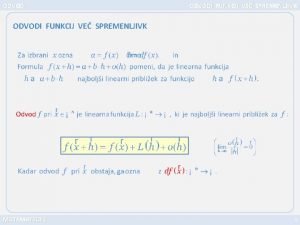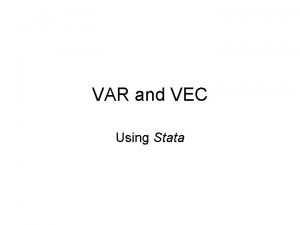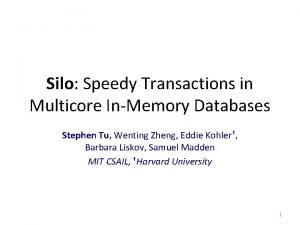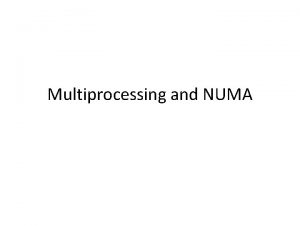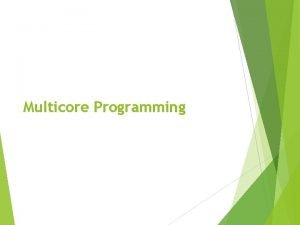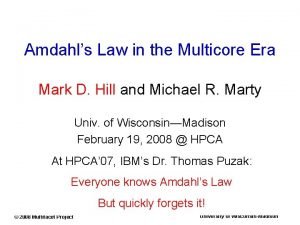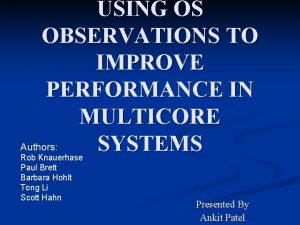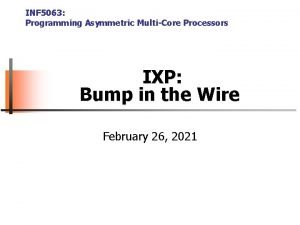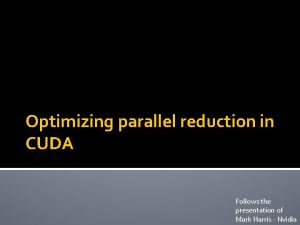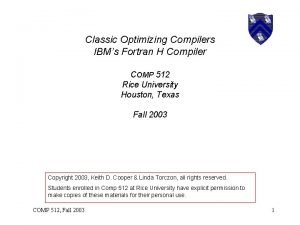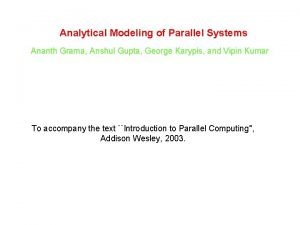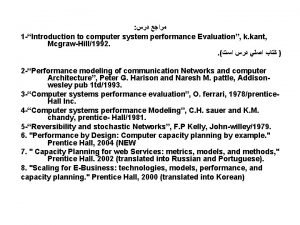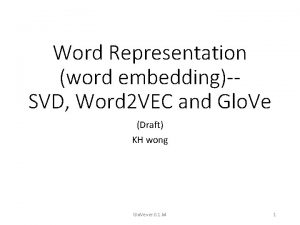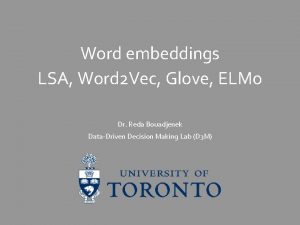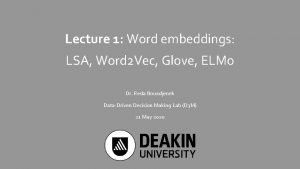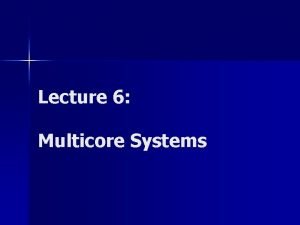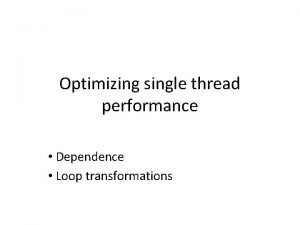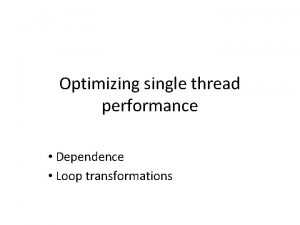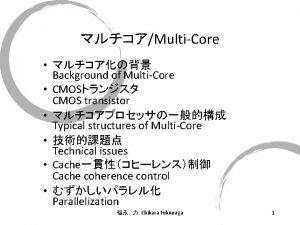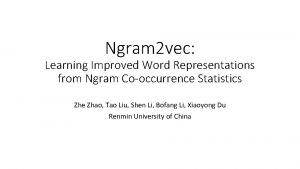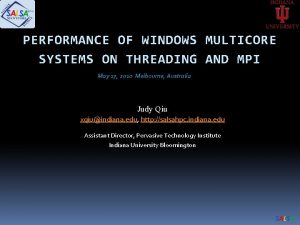Optimizing Word 2 Vec Performance on Multicore Systems









![p. Word 2 Vec Idea: Share negative samples among same context words [2] Advantages: p. Word 2 Vec Idea: Share negative samples among same context words [2] Advantages:](https://slidetodoc.com/presentation_image_h2/b049a3966182711f6cebbfdd25864310/image-10.jpg)




















- Slides: 30

Optimizing Word 2 Vec Performance on Multicore Systems Vasudevan Rengasamy, Tao-Yang Fu, Wang-Chien Lee, Kamesh Madduri The Pennsylvania State University 1

Acknowledgement This research is supported in part by the US National Science Foundation grants ACI-1253881, CCF-1439057, IIS-1717084, and SMA-1360205. This work used the Extreme Science and Engineering Discovery Environment (XSEDE), which is supported by National Science Foundation grant number ACI-1548562. 2

Outline • Introduction – Motivation for Word Embeddings – Prior work on optimizing Word 2 Vec • Our Context Combining optimization • Experiments and Results – Parallel performance – Evaluating Accuracy • Conclusion and Future work 3

Word embedding Learn low dimensional vector representation for words sunny bright Vectors of similar words are closer in the vector space Applications: • Document classification • Machine translation • Named entity recognition large 4

Word 2 Vec: A Word Embedding Technique Skip-gram model: Learn word representations by predicting words that occur in the same context as the target word Input context Target word 5

Two applications of Word 2 Vec Word Similarity score football soccer 0. 83 television radio 0. 76 precedent group -0. 05 listing proximity -0. 06 Word Analogy Question Predicted Word greece: athens france: ? paris greece: athens china: ? beijing 6

Aim Improve efficiency of Word 2 Vec training on multi-core systems by • Improving floating point throughput • Reducing overheads Avoid any accuracy loss due to performance optimization 7

Training SGNS model 1. 2. Select target word, input context Generate Samples day, bright, + day, sunny, + 3. Target word desert, bright, largest, sunny, - Update model parameters using Stochastic Gradient Descent (SGD) P(bright) day Word 2 Vec Update weights P(sunny) P(desert) 8

Prior Work 9
![p Word 2 Vec Idea Share negative samples among same context words 2 Advantages p. Word 2 Vec Idea: Share negative samples among same context words [2] Advantages:](https://slidetodoc.com/presentation_image_h2/b049a3966182711f6cebbfdd25864310/image-10.jpg)
p. Word 2 Vec Idea: Share negative samples among same context words [2] Advantages: • Matrix multiplications which are compute bound Limitations: • Small matrix Less floating point throughput • Overhead to create dense matrices 10

Context Combining 11

Context Combining: Overview C 1, C 2 – Related windows sharing samples 12

Context Combining: Steps 13

Preprocessing Create Inverse index for finding target word positions in training data segment Training Data segment Used for finding related windows that contain a given word as the target Inverse Index CSR representation used CSR representation 14

Experiments and Results 15

Experimental Setup System Description 1. Stampede supercomputer at TACC – 2 x 8 -core Intel Xeon E 5 (Sandy Bridge) processors and 32 GB DDR 3 memory 2. Stampede 2 supercomputer at TACC - 1 68 core Intel Xeon Phi 7250 Knights Landing (KNL) processor with 4 way SMT, 96 GB DDR 4, 16 GB MCDRAM Note: All our experiments were run on a single compute node. Datasets Training Data Test datasets 1. text 8 – 17 M words, Vocabulary Size – 71 K 2. 1 billion word benchmark (1 B) – 805 M words, Vocabulary size – 1. 1 M 1. Word. Sim 353 (ws 353) for word similarity test 2. Google analogy queries for word analogy tests 16

Multi-core performance comparison Intel Sandy Bridge: 16 threads Intel KNL: 272 threads For 1 B dataset, p. SGNScc achieves 1. 28 x speedup over p. Word 2 Vec in Stampede and 1. 11 x speedup in Stampede 2 17

Breakdown of time • Index overhead, Create in. M, Update Min – p. Word 2 Vec is faster • Create out. M, SGD computations, Update Mout – p. SGNScc is faster 18

Parallel Scaling 19

Evaluating Accuracy Similarity Method Analogy text 8 1 B Word 2 Vec . 671 . 636 . 297 . 330 p. Word 2 Vec . 682 . 639 . 309 . 327 p. SGNScc . 685 . 633 . 322 . 328 text 8 – Accuracy of p. Word 2 Vec and p. SGNScc better than Word 2 Vec 1 B – Accuracy of 3 methods are comparable 20

Performance impact of T and C Value of T Time per epoch (s) Index time (s) Avg. related windows (≤ 8) 100 K 500 K 1 M 2 M 220. 13 196. 03 196. 74 201. 13 17. 20 14. 85 17. 97 24. 22 5. 49 7. 53 7. 80 7. 92 Value of C Time per epoch (s) Index time (s) SGD Computations (s) 1 4 8 16 258. 38 208. 45 196. 03 191. 08 3. 16 12. 47 14. 92 20. 25 129. 94 108. 27 102. 12 95. 69 21

Conclusion and Future Work 22

Conclusion • Proposed new optimization technique called Context Combining for – Improving floating point throughput – Reducing Overhead • Speedup of up to 1. 28 x over p. Word 2 Vec and 3. 53 x over Google’s multi-threaded C implementation • Accuracy comparable to state-of-the-art implementations 23

Future Work • Floating point throughput is still less than peak performance – Explore alternate approaches context combining • Optimize Word 2 Vec for GPUs • Support distributed memory parallelism 24

References 1 2 3 4 Tomas Mikolov, Kai Chen, Greg Corrado, and Jeffrey Dean. 2013. Efficient Estimation of Word Representations in Vector Space. In Proc. Int’l. Conf. on Learning Representations (ICLR) Workshop. Shihao Ji, Nadathur Satish, Sheng Li, and Pradeep Dubey. 2016. Parallelizing Word 2 Vec in Multi-Core and Many-Core Architectures. In Proc. Int’l. Workshop on Efficient Methods for Deep Neural Networks (EMDNN). Recht, B. , Re, C. , Wright, S. , & Niu, F. (2011). Hogwild: A lock-free approach to parallelizing stochastic gradient descent. In Advances in neural information processing systems. Levy, O. , Goldberg, Y. , & Dagan, I. (2015). Improving distributional similarity with lessons learned from word embeddings. Transactions of the Association for Computational Linguistics, 3, 211 -225. 25

Paper doi>10. 1145/3149704. 3149768 Git. Hub Source code : vasupsu/p. Word 2 Vec. git Git. Hub Artifact : vasupsu/IA 3_Paper 16_Artifact. Evaluation. git Thank You Questions? For questions, Email: vxr 162@psu. edu 26

Skip-gram with Negative Sampling • Skip-gram model is slow due to Softmax function – O(V) computation per sample • Skip-gram with Negative Sampling (SGNS) model reduces the complexity – For each target word, choose K words (typically 5 -25) at random from the vocabulary – Target word = positive sample – K Random words = negative samples 27

Skip-gram with Negative Sampling • Probability calculation under SGNS model • Time complexity for processing 1 sample: O(K) • SGNS training: Use SGD to maximize P(y|x) for positive samples and minimize for negative samples • Parallelism achieved by processing contexts asynchronously (ignoring race conditions) 28

Context Combining: Steps Training Data T’ words Read T words, Mark target words as Unprocessed Preprocess Select an unprocessed target word Yes Identify C-1 related windows Perform SGD updates Mark target words as Processed Unprocessed target word present? No Epoch < I ? No 29 Output Model Parameters

Skip-gram with Negative Sampling Input context Target word Drawback: Vector products are memory-bound 30
 Node2vec scalable feature learning for networks
Node2vec scalable feature learning for networks Vec grundy va
Vec grundy va Funkcije več spremenljivk
Funkcije več spremenljivk Vec workforce connection
Vec workforce connection Doc to vec
Doc to vec Uniform vec3
Uniform vec3 Vector vacuums
Vector vacuums Vec stata
Vec stata Ivila
Ivila Speedy transactions in multicore in-memory databases
Speedy transactions in multicore in-memory databases Multicore packet scheduler
Multicore packet scheduler Multiprocessor and multicore
Multiprocessor and multicore Multiprocessor vs multicore
Multiprocessor vs multicore And eat
And eat Cache craftiness for fast multicore key-value storage
Cache craftiness for fast multicore key-value storage Multicore vs multiprocessor
Multicore vs multiprocessor Obs multicore
Obs multicore Asymmetric multicore processing
Asymmetric multicore processing Sae international
Sae international How is economizing different from optimizing?
How is economizing different from optimizing? Cuda parallel reduction
Cuda parallel reduction Cuda parallel reduction
Cuda parallel reduction The fortran optimizing compiler
The fortran optimizing compiler Dr moza
Dr moza Chapter 11 performance appraisal - (pdf)
Chapter 11 performance appraisal - (pdf) Behaviorally anchored rating scales
Behaviorally anchored rating scales Jcids manual 2018
Jcids manual 2018 Tpm system engineering
Tpm system engineering Performance management chapter 1
Performance management chapter 1 Performance metrics for parallel systems
Performance metrics for parallel systems Computer system performance evaluation
Computer system performance evaluation


